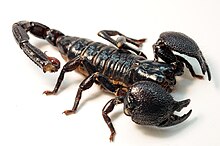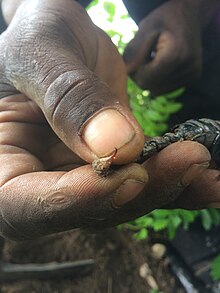Emperor scorpion
| Emperor scorpion | |
|---|---|

| |
| Scientific classification | |
| Domain: | Eukaryota |
| Kingdom: | Animalia |
| Phylum: | Arthropoda |
| Subphylum: | Chelicerata |
| Class: | Arachnida |
| Order: | Scorpiones |
| Family: | Scorpionidae |
| Genus: | Pandinus |
| Species: | P. imperator
|
| Binomial name | |
| Pandinus imperator (Koch,1842)
| |


Theemperor scorpion(Pandinus imperator)is aspeciesofscorpionnative to rainforests and savannas inWest Africa.It is one of the largest scorpions in the world and lives for 6–8 years. Its body is black, but like other scorpions it glows pastel green or blue underultraviolet light.It is a popular species in thepet trade,and is protected byCITESto prevent over-collecting that might affect the species' survival.
Description
[edit]
The emperor scorpion (Pandinus imperator) is one of the largest species of scorpion in the world, with adults averaging about 20 centimetres (7.9 in) in length and a weight of 30 g.[2]However, some species of forest scorpions are fairly similar to the emperor scorpion in size, and one scorpion,Heterometrus swammerdami,holds the record for being the world's largest scorpion at 9 inches (23 cm) in length.[3]The large pincers are blackish-red and have a granular texture. The front part of the body, orprosoma,is made up of four sections, each with a pair of legs. Behind the fourth pair of legs are comb-like structures known aspectines,which tend to be longer in males than in females. The tail, known as themetasoma,is long and curves back over the body. It ends in the large receptacle containing the venom glands and is tipped with a sharp, curvedstinger.Scorpion stings can be categorized as mild (similar to a bee sting) to severe to humans depending on the species. Most people are not severely affected by the emperor scorpion's sting, though some people may be allergic to scorpion stings in general.[4]Sensory hairs cover the pincers and tail, enabling the emperor scorpion to detect prey through vibrations in the air and ground.[5]
When gravid (pregnant), the body of a female expands to expose the whitish membranes connecting the segments. The emperor scorpion fluoresces greenish-blue underultra-violetlight.[6][7]
They are known for their docile behavior and almost harmless sting; they do not use their sting to defend themselves when they are adults, however, they may use it in their adolescent stages. They prefer to use their pincers to crush and dismember their prey. Their exoskeleton is verysclerotic,causing them to have a metallic greenish-black color.
Emperor scorpions are often confused with a similar genus (Heterometrus), and are one of the most famous scorpions.
Differention channel toxinshave been isolated from the venom of the emperor scorpion, including Pi1,[8]Pi2,[9][10]Pi3,[9]Pi4[11]and Pi7.[12]
Habitat and distribution
[edit]The emperor scorpion is an African rainforest species,[13]but also present insavanna.It is found in a number of African countries, includingBenin,Burkina Faso,Côte d’Ivoire,Gambia,Ghana,Guinea,Guinea-Bissau,Togo,Liberia,Mali,Nigeria,Senegal,Sierra LeoneandCameroon.[7]
This species inhabits bothtropical forestand open savannas. The emperor scorpion burrows beneath the soil and hides beneath rocks and debris,[5]and also often burrows intermite mounds.[14]
Feeding habits
[edit]In the wild, emperor scorpions primarily consume insects and other terrestrial invertebrates, although termites constitute a large portion of their diet. Larger vertebrates, such as rodents and lizards, are occasionally eaten. Emperor scorpions will burrow through termite mounds up to 6 feet deep in order to hunt prey. Their large claws help in tearing apart prey while their tail stinger injects venom at the same time for liquifying food. Juveniles rely on their venomous sting to paralyze prey while adults use their large claws to tear apart prey.
Conservation and human impact
[edit]-
Young female emperor scorpion kept as a pet
-
P. imperatoris very docile and tolerant of human contact.
African emperor scorpionvenomcontains the toxinsimperatoxin[15]andpandinotoxin.
Due to its docile nature, large size, and hardiness,P. imperatoris a popularscorpionin the pet trade, which has led to such over-collecting in the wild that it is now aCITES-listedanimal.[1]They feed readily on crickets and worms available to keepers, and they can live up to 8 years in captivity.
References
[edit]- ^abUNEP-WCMC."Pandinus imperator(Koch, 1841) ".UNEP-WCMC Species Database: CITES-Listed Species.Archived fromthe originalon 7 August 2011.Retrieved11 June2011.
- ^ARKive
- ^Manny Rubio (2000)."Commonly Available Scorpions".Scorpions: Everything About Purchase, Care, Feeding, and Housing.Barron's Educational Series. pp.26–27.ISBN978-0-7641-1224-9.
The emperor scorpion can reach an overall length of more than 8 inches (20 cm). It is erroneously claimed to be the largest living scorpion in the world. However, some species of Forest Scorpions are its equal. [...] Emperor scorpions have the same venom as a bee.The Guinness Book of Records claims a Forest Scorpion native to rural India,Heterometrus swammerdami,to be the largest scorpion in the world (9 inches [23 cm]).
- ^"Scorpion Emperor Care Sheet"(PDF).Petco. 2004. Archived fromthe original(PDF)on 2009-07-11.Retrieved2012-03-24.
- ^ab"Emperor Scorpion".The Animal Information Centre. March 2005.Archivedfrom the original on 2013-09-21.Retrieved2011-09-15.
- ^"Emperor Scorpion".The Big Zoo. March 2005. Archived fromthe originalon 2011-08-04.
- ^abEmperor scorpionmedia fromARKiveAccessed October 20, 2011.
- ^Olamendi-Portugal, T.; Gómez-Lagunas, F.; Gurrola, G. B.; Possani, L. D. (1996-05-01)."A novel structural class of K+-channel blocking toxin from the scorpion Pandinus imperator".The Biochemical Journal.315(3): 977–981.doi:10.1042/bj3150977.ISSN0264-6021.PMC1217303.PMID8645186.
- ^abGómez-Lagunas, F.; Olamendi-Portugal, T.; Zamudio, F. Z.; Possani, L. D. (1996-07-01). "Two novel toxins from the venom of the scorpion Pandinus imperator show that the N-terminal amino acid sequence is important for their affinities towards Shaker B K+ channels".The Journal of Membrane Biology.152(1): 49–56.doi:10.1007/s002329900084.ISSN0022-2631.PMID8660410.S2CID20551964.
- ^Klenk, K. C.; Tenenholz, T. C.; Matteson, D. R.; Rogowski, R. S.; Blaustein, M. P.; Weber, D. J. (2000-03-01). "Structural and functional differences of two toxins from the scorpion Pandinus imperator".Proteins.38(4): 441–449.doi:10.1002/(sici)1097-0134(20000301)38:4<441::aid-prot9>3.0.co;2-l.ISSN0887-3585.PMID10707030.
- ^Olamendi-Portugal, T.; Gómez-Lagunas, F.; Gurrola, G. B.; Possani, L. D. (1998-05-01). "Two similar peptides from the venom of the scorpion Pandinus imperator, one highly effective blocker and the other inactive on K+ channels".Toxicon.36(5): 759–770.doi:10.1016/s0041-0101(97)00163-3.ISSN0041-0101.PMID9655636.
- ^Delepierre, M.; Prochnicka-Chalufour, A.; Boisbouvier, J.; Possani, L. D. (1999-12-21). "Pi7, an orphan peptide from the scorpion Pandinus imperator: a 1H-NMR analysis using a nano-NMR Probe".Biochemistry.38(51): 16756–16765.doi:10.1021/bi991685m.ISSN0006-2960.PMID10606507.
- ^Rod Preston-Mafham; Ken Preston-Mafham (1993).The Encyclopedia of Land Invertebrate Behaviour.Cambridge, Massachusetts:MIT Press.ISBN978-0-262-16137-4.
- ^"Scorpion Systematics Research Group".American Museum of Natural History.November 2008.RetrievedOctober 20,2011.
- ^Fernando Z. Zamudio; Renaud Conde; Carolina Arévalo; Baltazar Becerril; Brian M. Martin; Hector H. Valdivia; Lourival D. Possani (1997)."The mechanism of inhibition of ryanodine receptor channels by imperatoxin I, a heterodimeric protein from the scorpionPandinus imperator".Journal of Biological Chemistry.272(18): 11886–11894.doi:10.1074/jbc.272.18.11886.PMID9115249.
External links
[edit] Media related toPandinus imperatorat Wikimedia Commons
Media related toPandinus imperatorat Wikimedia Commons


